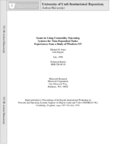1 - 25 of 5
| Creator | Title | Description | Subject | Date | ||
|---|---|---|---|---|---|---|
| 1 |
 |
Harrison, Reid R. | Analog VLSI model of the fly elementary motion detector | Flies are capable of rapidly detecting and integrating visual motion information in behaviorly-relevant ways. The first stage of visual motion processing in flies is a retinotopic array of functional units known as elementary motion detectors (EMDs). Several decades ago, Reichardt and colleagues de... | 1998-01-01 | |
| 2 |
 |
Furse, Cynthia M.; Lazzi, Gianluca; Gandhi, Om P. | Comparison of FDTD computed and measured radiation patterns of commercial mobile telephones in presence of the human head | In this letter, finite-difference time-domain (FDTD) computed radiation patterns of mobile telephones are carefully compared with those measured in our laboratory. The question on the capability of the FDTD method to correctly predict the radiated electromagnetic fields of today's structurally comp... | FDTD; Finite-difference time-domain; Mobile antennas | 1998-01-01 |
| 3 |
 |
Furse, Cynthia M.; Gandhi, Om P. | Computations of SAR distributions or two anatomically based models of the human head using CAD files of commercial telephones and the parallelized FDTD code | A method for importing data from computer-aided design (CAD) files for a mobile telephone into finite-difference time-domain (FDTD) simulation software is described. Although the FDTD method is well suited for the bio-electromagnetic simulations and has become the method of choice for most research... | Specific absorption rates; SAR; CAD files; FDTD; Finite-difference time-domain | 1998-01-01 |
| 4 |
 |
Regehr, John | Issues in using commodity operating systems for time-dependent tasks: experiences from a study of windows NT | This paper presents a snapshot of early results from a study of Windows NT aimed at understanding and improving its limitations when used for time-dependent tasks, such as those that arise for audio and video processing. Clearly there are time scales for which it can achieve effectively perfect reli... | 1998-01-01 | |
| 5 |
 |
Mathews, V. John | Perceptually lossless image compression | This paper presents an algorithm for perceptually lossless image compression. A compressed image is said to be perceptually lossless for a specified viewing distance if the reconstructed image and the original image appear identical to human observers when viewed from the specified distance. Our app... | 1998-01-01 |
1 - 25 of 5
